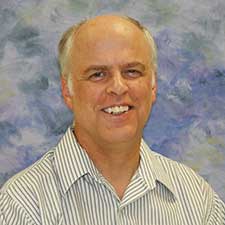
Timothy Hughbanks
Professor
Associate Head, Department of Chemistry
Solid state chemists are playing a crucial role in shaping the future of chemistry through the synthesis of new materials with novel properties. We combine the traditional strengths of molecular chemists with those of materials scientists to study interesting materials while training versatile scientists.
In the solid state, a stunning variety of interstitially centered zirconium and lanthanide clusters can be synthesized. Zirconium clusters can then be excised from the solid state networks in which they are ensconced and extracted into solution. Spectroscopy of centered clusters such as the one depicted are remarkably powerful for analytical purposes and for probing the clusters' electronic structure. We have shown that gadolinium clusters exhibit strong ferromagnetic coupling that should, if they can be excised from their solid-state precursors, yield molecules with large, thermally robust magnetic moments. Ferromagnetic coupling of the 4f-electron magnetic moments occurs when there are delocalized unpaired 5d electrons through which the coupling is mediated. Lanthanide-based clusters are of particular interest because facile substitution of Ln elements (e.g., Tb in the place of Gd - see figure) allows for some measure of control of their magnetic anisotropy and opens possibilities for their use in a new class of single-molecule magnets.
We have undertaken a fundamental program in the synthesis of metal chalcogenide solids. Over the years we've found new tantalum sulfides (such as Ta3S2), zirconium and hafnium tellurides (such as Zr3Te4, Hf3Te4 and Hf8Te6(Mn,Fe)), and an unusual polar layered material, NaMnTe2. These compounds are offer exciting potential as polar "host" templates for orienting nonlinear optical chromophores as "guests" in the spaces between layers. A new avenue in chalcogenide research will be to explore the possibility that a pre-synthesized cluster core (like [Mo4Se4]6+) can be incorporated into porous networks where clusters with the same connectivity (like Zn4O6+) are found. Since the former clusters are electroactive and the latter are not, this suggests more versatile set of materials with interesting properties and reactivity might be synthesized.
Students have the opportunity to learn and use a wide of variety of techniques in synthesis, single crystal and powder X-ray diffraction, UV-vis, IR, and NMR spectroscopies, measurement of electrical and magnetic properties, and theoretical electronic structure calculations.
Figure Caption: When Gd clusters have Gd-Gd bonding orbitals filled, the 4f-moments are weakly coupled. When unpaired d-electrons are present, 4f-moments couple strongly. The addition of a f8 Tb center may lock the coupled moments along a preferred crystallographic direction.
B. S., 1977, University of Washington
M. S., 1980, Cornell University
Ph. D., 1983, Cornell University
Postdoctoral Fellow, 1982-85, University of Chicago
Postdoctoral Fellow, 1985-87, Iowa State University